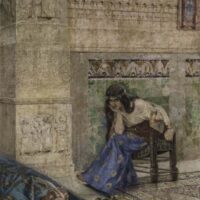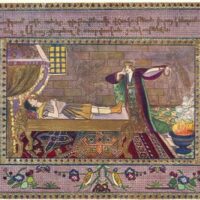Ara : The Handsome King
Listen
At a glance
| Description | |
|---|---|
| Origin | Caucasus Mythology |
| Classification | Mortals |
| Family Members | Aram (Father) |
| Region | Armenia |
| Associated With | Royalty, Handsomeness |
Ara
Introduction
Ara the Handsome (Armenian: Արա Գեղեցիկ, Ara Gełec‘ik) stands as one of the most celebrated figures in Armenian mythology, remembered for his beauty, valor, and tragic fate. His story, deeply intertwined with Queen Semiramis of Assyria, has been preserved for centuries as both myth and cultural memory. To the ancient Armenians, Ara was more than just a king—he embodied the eternal cycle of life, death, and renewal. Pagan Armenians often viewed him as a divine or semi-divine being, a reflection of older fertility and sun-worship traditions. By the time Armenia converted to Christianity in the 4th century, Ara’s legend had shifted, casting him as a mortal hero rather than a god, yet his symbolic power remained intact. His myth continues to bridge ancient Indo-European religious motifs with Armenian identity, making Ara a cornerstone of the nation’s mythological and historical imagination.
Physical Traits
Ara’s epithet “the Beautiful” or “the Handsome” was not merely poetic—it was central to his myth. Ancient sources describe him as a warrior of striking appearance, with features so captivating that Semiramis herself fell hopelessly in love with him. His beauty was considered both human and divine, an idealized form of masculine perfection. Artists and poets often depicted him as tall, strong, and radiant, with flowing hair and noble bearing, the embodiment of Armenian ideals of kingly grace. Some scholars suggest Ara may have originated as a deified figure linked to the sun god Arev, symbolizing warmth, fertility, and cosmic brilliance. This association underscores the duality of Ara: both a man of flesh and blood and a mythic image of divine beauty.
Family
Ara is placed within Armenia’s mytho-historical royal lineage, which traces back to Hayk, the legendary patriarch of the Armenian people. According to tradition, Ara was the son of King Aram, himself a descendant of Hayk. This ancestry is significant because it situates Ara within a continuum of foundational figures who shaped Armenia’s cultural and spiritual identity. Hayk embodied sovereignty and freedom, Aram represented military valor, and Ara became the symbol of beauty and fertility. Ara’s marriage to Nouard and his role as father further highlight his place within the dynastic traditions of Armenia. Some accounts note that after Ara’s death, Semiramis claimed to have named his son Ara or Karthos, ensuring his legacy continued through bloodline and story alike.
Other names
The most common name attached to him is Ara Geghetsik, literally “Ara the Beautiful” in Armenian. In some variations, he is also called Ara the Sightly or Ara the Handsome. The name “Ara” itself carries deep linguistic and symbolic weight. Scholars have suggested that it may connect to Proto-Indo-European roots associated with bravery and masculinity, reflected in Armenian words such as ayr (man) and ari (brave). In earlier cultic traditions, Ara was associated with the sun (Arev) and springtime renewal, making his very name synonymous with natural cycles of life. A curious detail in folklore is the stork, or aragil, which was regarded as Ara’s messenger and guardian of the fields—an emblem of his role as protector and nurturer of life.
Powers and Abilities
Though later narratives portray Ara as a mortal king, his mythic essence reflects the archetype of the dying-and-rising god. He was linked to agricultural fertility, the seasonal rhythms of death in winter, and rebirth in spring. In the legendary battle against Semiramis’s armies, Ara is slain, but the queen refuses to accept his death. In some versions, she attempts to resurrect him through sorcery and prayers. More enduring, however, is the tale of the Aralezner, divine dog-like spirits who descend from the heavens to lick the wounds of fallen warriors, restoring them to life. These beings are among the most ancient figures of the Armenian pantheon, symbolizing hope and the triumph of renewal over death. Ara’s connection to them highlights his role as a liminal figure between mortality and divinity. His myth also carries echoes of Near Eastern deities such as Tammuz and Adonis, who represented the eternal cycle of fertility, love, and loss. Beyond resurrection, Ara is tied to the prosperity of crops and the renewal of the land, aligning him with the agricultural heart of Armenian culture.
Modern Day Influence
The legacy of Ara the Handsome extends far beyond myth, shaping Armenian identity, art, and collective memory. The battlefield where Ara is said to have fallen was traditionally called the Plain of Ara, underscoring how myth and geography intertwine. The name Ararat, associated with the iconic mountain and the Armenian homeland itself, is thought by some scholars to carry echoes of Ara’s legend. The city of Van, still referred to as Shamiramagerd—“the city of Semiramis”—testifies to how the myth of Ara and Semiramis left a lasting imprint on Armenian historical consciousness.
Artists and writers across centuries have drawn upon Ara’s myth. The 19th-century painter Vardges Sureniants depicted Semiramis mourning over Ara’s lifeless body, capturing the tension between beauty, tragedy, and desire. Armenian epic poetry, folklore, and modern literature continue to reference Ara as a symbol of resilience and rebirth. In academic circles, scholars like Armen Petrosyan have analyzed Ara within the framework of Indo-European mythology, identifying him as part of a triad of mythic roles alongside Hayk and Aram.
Today, Ara is celebrated as both a cultural and national symbol. For Armenians, he embodies not only physical beauty but also the spirit of resistance and regeneration. His death and symbolic resurrection have been interpreted as metaphors for Armenia’s survival through centuries of invasion, exile, and rebirth. In modern nationalist and cultural discourse, Ara serves as a reminder of Armenia’s enduring heritage, bridging the gap between ancient myth and contemporary identity.
Related Images
Source
Wikipedia contributors. (n.d.). Ara the Handsome. Wikipedia. Retrieved September 9, 2025, from https://en.wikipedia.org/wiki/Ara_the_Handsome
Torkomyan, H. (2017, June 21). The Dog Like Gods Of Ancient Armenians: Aralez. History of Armenia. Retrieved from https://historyofarmenia.org/2017/06/21/dog-like-gods-ancient-armenians-aralez/
Ghapantsyan, G. (1944). Ara Geghets’ki pashtamunk’e [The Cult of Ara the Handsome]. Erevan: Robert Bedrosian Library. Retrieved from https://archive.org/details/ghapantsyan-1944-ara
Frequently Asked Questions
What is lorem Ipsum?
I am text block. Click edit button to change this text. Lorem ipsum dolor sit amet, consectetur adipiscing elit. Ut elit tellus, luctus nec ullamcorper mattis, pulvinar dapibus leo.
What is lorem Ipsum?
I am text block. Click edit button to change this text. Lorem ipsum dolor sit amet, consectetur adipiscing elit. Ut elit tellus, luctus nec ullamcorper mattis, pulvinar dapibus leo.
What is lorem Ipsum?
I am text block. Click edit button to change this text. Lorem ipsum dolor sit amet, consectetur adipiscing elit. Ut elit tellus, luctus nec ullamcorper mattis, pulvinar dapibus leo.
What is lorem Ipsum?
I am text block. Click edit button to change this text. Lorem ipsum dolor sit amet, consectetur adipiscing elit. Ut elit tellus, luctus nec ullamcorper mattis, pulvinar dapibus leo.
What is lorem Ipsum?
I am text block. Click edit button to change this text. Lorem ipsum dolor sit amet, consectetur adipiscing elit. Ut elit tellus, luctus nec ullamcorper mattis, pulvinar dapibus leo.








